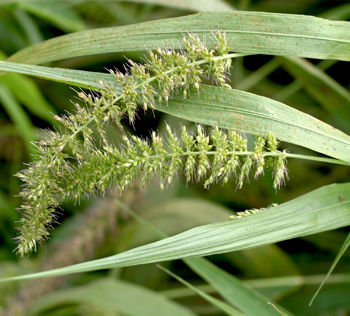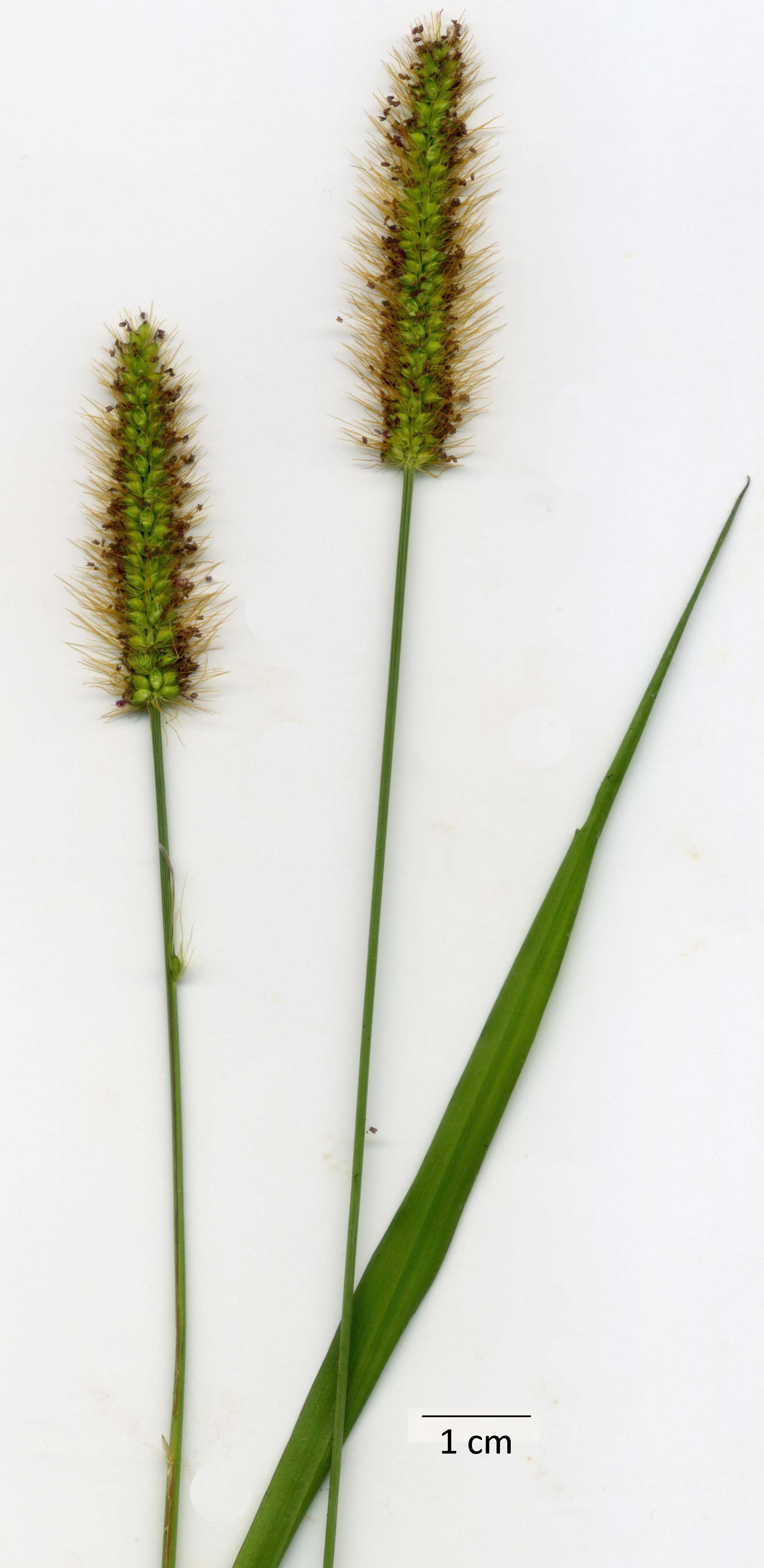|
|
|
[FOXTAIL GRASSES]
|
|
|
|
|
44a
|
(23) |
 Spikelets numerous on short branches arranged in whorls on the axis (a verticillate panicle), each spikelet with a single (sometimes 2), about 1/8 in (0.5 cm) bristle below. Leaves broad near middle, gradually tapering outward. Ligule ciliate. { Clumping, medium size annual. At maturity the spikelet bristles readily catch on each other and on clothing, forming entangled masses difficult to remove from fabric. Typically found in disturbed, dry to mesic environments (Fig. 8C). Bristly foxtail [HAW - NAT] [FACU] barbed foxtail [GUM - NAT]
Spikelets numerous on short branches arranged in whorls on the axis (a verticillate panicle), each spikelet with a single (sometimes 2), about 1/8 in (0.5 cm) bristle below. Leaves broad near middle, gradually tapering outward. Ligule ciliate. { Clumping, medium size annual. At maturity the spikelet bristles readily catch on each other and on clothing, forming entangled masses difficult to remove from fabric. Typically found in disturbed, dry to mesic environments (Fig. 8C). Bristly foxtail [HAW - NAT] [FACU] barbed foxtail [GUM - NAT] Setaria adhaerens (Forrsk.) Chiov.
|
|
44b
|
|
Inflorescence not as above; usually with only one spikelet per branch, the branches not obviously whorled on the axis or spikelets too condensed to determine. Bristles (or short awns) attend each spikelet, these either loosely catching on clothing or not (or may remain on the axis at maturity). Ligule ciliate or membranous .. .
|
|
[45]
|
|
~~~~ ~~~~~~~~~~~~~~~~~~~~~~~~~
|
|
|
45a
|
(44) |
Bristles surrounding the spikelet (as an involucre) remaining attached to the spikelet when spikelet separates from the rachis; bristles soft or hard. Spikelet a bur or bur-like, globose, narrow ovate, or spindle-shaped. Cenchrus spp.
|
|
[48] |
|
45b
|
|
Bristles fine, hair-like, either subtend (lie beneath) the spikelet or on glumes. Spikelet not a bur .. .
|
|
[46] |
|
~~~~ ~~~~~~~~~~~~~~~~~~~~~~~~~
|
|
|
46a
|
(45) |
Dense "bristles" are actually fine awns arising on the glumes. Inflorescence a dense, cylindrical "foxtail", bluntly rounded at tip. Polypogon spp. .. .
|
|
[50] |
|
46b
|
|
Bristles radiate from base of spikelet. Inflorescence cylindrical to linear, tapering towards the tip, spike-like or with branches held vertical, close against the rachis .. .
|
|
[47] |
|
~~~~ ~~~~~~~~~~~~~~~~~~~~~~~~~
|
|
|
47a
|
(46) |
Floret ellipsoid to lanceolate, but with both glumes extending well-beyond the floret. Numerous soft bristles surround base of spikelet. Leaves growing mostly from plant base up to 2 m (6 ft) or more in length. Ligule a ciliate membrane. Imperata spp. .. .
|
|
[49] |
|
47b
|
|
Spikelet ellipsoid (compressed, egg-shaped); glumes not conspicuously longer than floret; bristles antrorsely barbed. Ligule ciliate (a row of long hairs). Setaria spp. .. .
|
|
[48] |
|
~~~~ ~~~~~~~~~~~~~~~~~~~~~~~~~
[NOTE THREE CHOICES HERE]
|
|
|
48a
|
(47) |

Perennial. Inflorescence 2 to 6 cm (3/4 to 4 in) long. Spikelets somewhat inflated; Upper glume nearly as long as floret, lower much shorter; lemma surface rugose { Medium size (or sometimes small) clumping grass found in disturbed areas. Yellow foxtail, perennial foxtail, mau‘u Kaleponi. [HAW - NAT] [FACU] [?GUM - NAT] Setaria parviflora (Poir.) Kerguélen
|
|
|
48b
|
|
Perennial. Inflorescence 3 to 50 cm (1.1 to 18 in) long. Bristles often orange, present in groups of three. Glumes and lemma much as in S. parviflora { medium to large, densely cespitose, perennial grass, tolerant of flooded ground (see Figure 8E at bottom of page). [HAW - NAT] [FAC] African bristle grass [?GUM - NAT] Setaria sphacelata (Schumach.) Stapf & C.E. Hubb ex M.B. Moss
|
|
|
48c
|
|
Annual. Very similar to S. parviflora and S. sphacelata; not a perennial. Yellow bristle grass [GUM - NAT] Setaria pumila (Poir.) Roem. & Schult. |
|
|
~~~~ ~~~~~~~~~~~~~~~~~~~~~~~~~
|
|
|
49a
|
(47) |
Panicle up to 30 cm (1 ft) long with brances up to 2 cm (1 in) long, appressed to the rachis and concealed by the spikelets. Two stamens per floret. Leaves with off-center, whitish mid-rib. { Widespread on Guam, spreading to form dense stands. USDA & HDA noxious weed. Cogongrass [GUM - NAT] [UPL] Imperata cylindrica (L.) P. Beauv.
Cogongrass (both species found on Guam) is regarded as one of the ten worst weeds in the world (Global Invasive Species Database, 2021 cited in Faccenda, 2022) and was observed as an ornamental in Kane‘ohe, O‘ahu in 2007; since eradicated). May be sold as an ornamental cultivar distinguished by the unique characteristic of having the leaves colored red above the middle, green below; and having some leaf midveins located off-center.
|
|
|
|
49b
|
|
Panicle up to 50 cm (1.5 ft) long with brances to 6 cm (2.4 in) or longer, ascending, not so concealed by the spikelets. One stamen per floret. { Resembling I. cylindrica, but larger. [GUM - NAT] Imperata conferta (J. Presl) Ohwi
|
|
|
|
~~~~ ~~~~~~~~~~~~~~~~~~~~~~~~~
|
|
|
50a
|
(46) |
Glumes acute or rounded, rarely bifid at tip; awns on glumes short, between 1 and 4 mm long { Medium size, perennial tufted grass found in generally wet areas. [HAW - NAT] [FACW]
|
|
|
50b
|
|
Glumes typically bifid at tip; awns twice length of glume, between 4 and 7 mm long { Medium size, annual tufted grass found in generally wet areas. Rabbitfoot grass [HAW - NAT] [FACW]Polypogon monspeliensis (L.) Desf.
|
|